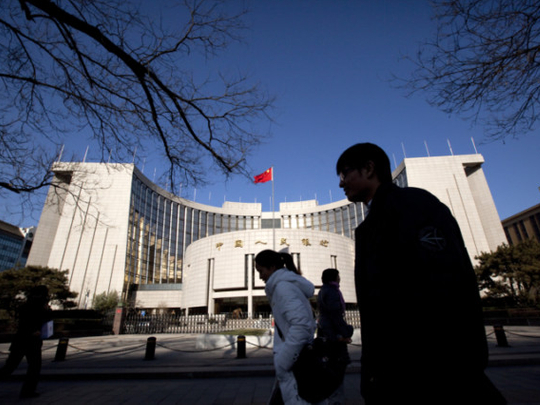
Shanghai: China’s central bank completed its largest weekly injection of funds into China’s banking system in seven months on Thursday, aiming to give banks cash needed to support the economy following their weakest month for lending in a year.
In a move that traders and analysts saw as a substitute for a cut in banks’ required reserve ratio (RRR), the People’s Bank of China (PBOC) injected a net 278 billion yuan (Dh160.75 billion, $43.77 billion) into the interbank money market this week, the largest net injection since early January.
Through last week, traders and analysts had widely expected that an RRR cut was imminent. Most believe that the central bank will still cut RRR by an additional 100 bps this year, in two increments of 50 basis points, one of which is expected in the third quarter.
“I would cut RRR tomorrow,” Ting Lu, economist at Bank of America-Merrill Lynch, told Reuters.
New yuan loans totalled 540 billion yuan in July, the lowest monthly total since July 2011. Exports and industrial output data also have indicated broad weakness in the economy.
The cash injection comes on the same day that a private survey showed China’s factories contracted by the most in nine months, hit by falling export orders and rising inventories.
PBOC’s decision to inject the funds through open market operations, rather than a cut in RRR, reflected the central bank’s abiding concern about stoking inflation, having already cut interest rates.
The central bank has lowered its benchmark interest rate twice this year, in June and July, putting the one-year deposit rate at 3 percent and the one-year loan rate at 6 percent.
And house prices have now risen for two straight months on a monthly basis, following eight consecutive monthly declines resulting from Beijing’s campaign to bring prices down.
Prices of agricultural produce have also crept up for five straight weeks, Ministry of Commerce data shows.
“The difference between ‘RRR cut plus forward repos’ and reverse repos is that reverse repos offer more flexibility and precision,” Ma Yun, economist at CEBM, a Chinese macro-economic consultancy, said in a note to clients.
The flexibility comes from the fact that reverse repos are short-term - either seven- or 14-days - so their effect is temporary. They can also be targeted at specific banks in need of liquidity.
By contrast, an RRR cut affects all banks and is effectively permanent unless the central bank moves actively to reverse it.
But traders say the capacity of short-term reverse repos to bring down money rates is limited.
“It creates more uncertainty because you never know what the central bank is going to do next week (when the repos mature),” said a money market trader at an Asian bank in Shanghai.
Analysts believe that in addition to reflecting concerns about inflation, the shift towards open market operations also reflects a broader effort to shift monetary policy away from quantitative tools such as RRR and towards price-based mechanisms used by central banks in advanced economies.
The central bank wants to establish the Shanghai Interbank Offered Rate, known as SHIBOR, as the key benchmark for China’s monetary policy, Ma said.
“This monetary policy reflects an emphasis on structural adjustment and worries about a rebound in house prices, but more importantly it is the cultivation of an interest-rate transmission mechanism in order to push forward the process of interest-rate liberalization,” he wrote.
The effect of interbank money market rates on the loan rates that banks offer customers has become more marked in the last two years, Ma said.
A monetary policy based on targeting SHIBOR would bring China into line with countries like the United States, where the Federal Reserve conducts repos in open market operations to target the federal funds rate. The effect of the changes in this short-term rate then cascades down the yield curve, influencing longer-term rates.
“All tools must be made available,” PBOC governor Zhou Xiaochuan told reporters on the sidelines of a conference Tuesday in Beijing, when asked whether he favoured money market operations over interest rates, or reserve rate requirements (RRR) to manage policy settings in the current environment.
China has taken cautious steps this year towards loosening government control on interest rates. In June, the central bank granted banks greater flexibility to set deposit and lending rates above or below the official benchmarks.
Traders on Tuesday reported that liquidity in China’s interbank market had improved, though rates were mixed.
The benchmark seven-day repo rate was essentially flat at 3.8053 percent near midday, as was overnight rate was also little changed.
But the 14-day rate, which hit a seven-month high on Tuesday, plummeted by more than 50 basis points.












